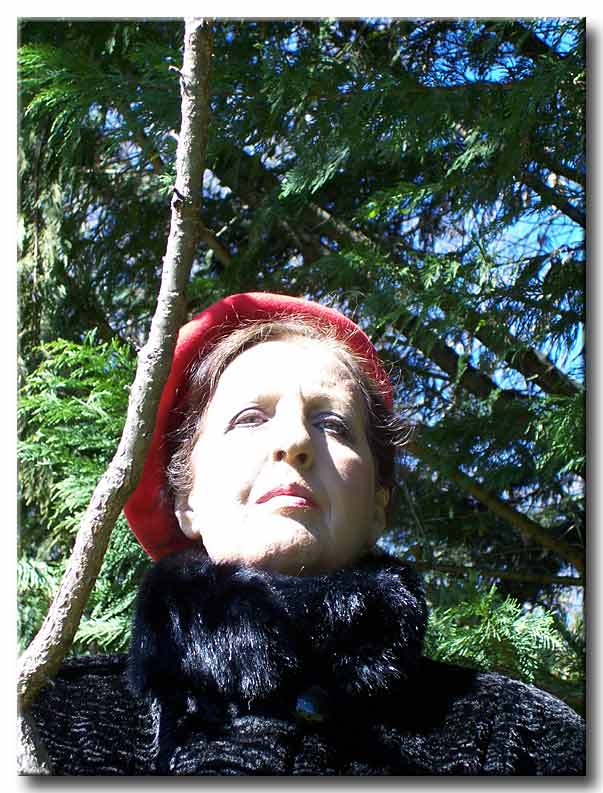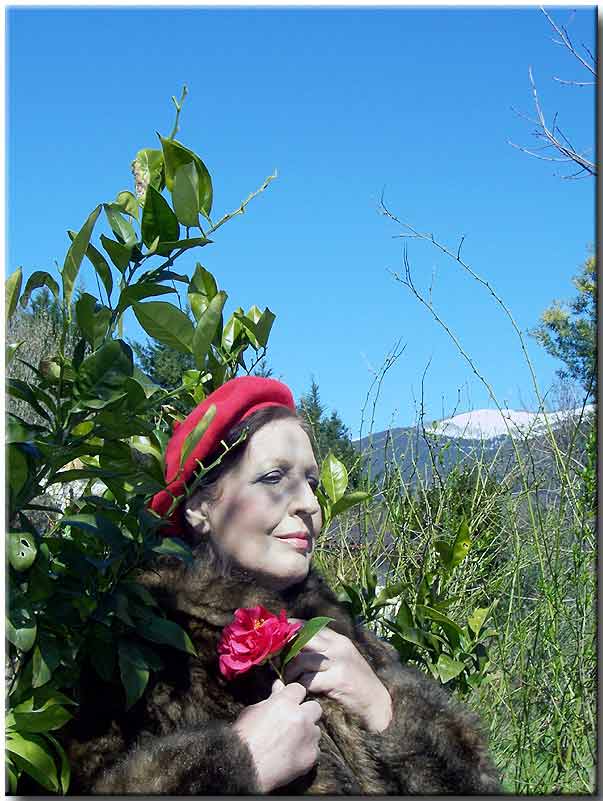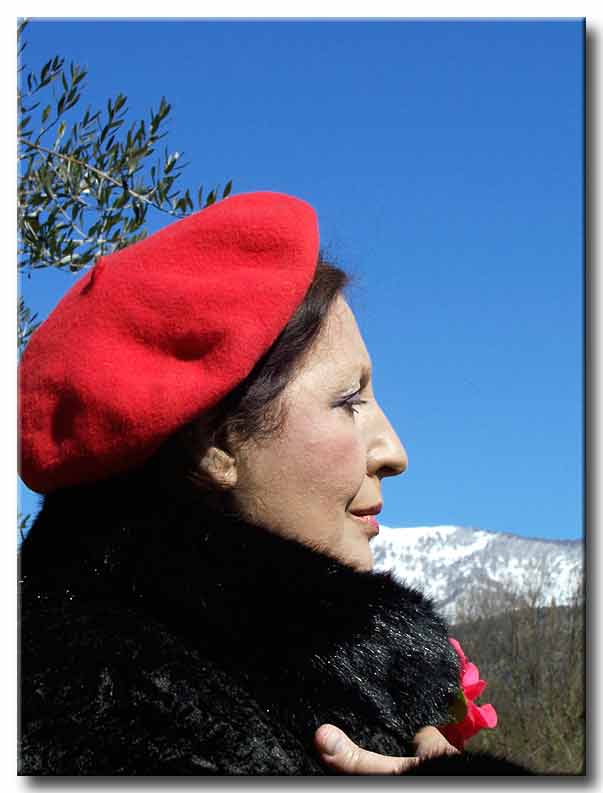|
NELLA
ANFUSO, CANTATRICE
by
Carlo Maria Cella
“...
the order in which all of the Airs divided into three segments should be
sung. The first part requires few and simple ornaments in order that the
air’s composition remains faithful. The second part requires that a
singular artifice is added to the original purity, in order that the
listener recognizes the art of the singer. Repeating the da capo of the
Airs, he who does not vary the musical phrases, bettering them from
previous phrases, can not be considered a great Man”.
(P.F. Tosi, Opinioni de’
Cantori Antichi e Moderni, 1723)
When the works of the “Cantatas and
Motets” by Vivaldi appeared, for Arion in 1982, the precept of Pier
Francesco Tosi, first commandment of the tables of the law inscribed in
the “Opinioni de’ Cantori Antichi e Moderni” in the year 1723,
obtained a value before unknown. Not through the fault of Tosi. The
parameter of measurement from a moral point of view for those who merit
the term singer of Italian music of the highest level, in the Music tout
court, changed the threshold of tolerance not because the force and
clarity of the precept changed, but because appeared a song that clung
like a glove to its models and around it mutated automatically the
landscape of sound, its examples and values. The “classifications”
that consciously or unconsciously were drafted, had to be rewritten. In
other words the grade had to be lowered. That this did not occur as
well and as much as it should have been, is an other chapter
in the history of interpretation that goes under various titles:
Decline of the Empire, Barbaric Invasions, a choice without
pretence of originality.

It seems almost that the portent of
the cantata “Cessate, omai cessate” attacks us: the rotund sound
heavy with “affections” in the Largo e sciolto; the
pearly spiccato, trills with staccato notes in
the Andante molto and Larghetto, on the polished
syllabifications of “Dorilla”, “ingrata”, “astringe”
and “lagrimar” and to end the inexorable progression of the
reprises, like Tosi enjoined, the crescendo of the embellishments of the
Allegro, chasing and following hard on each other in the “orrido”,
“albergo”, “ricetto”, “tormento” and again “Dorilla”,
“spietata”, “ingrata”, “morire”, “potrò”,
colliding in a disciplined manner in the circle of R’s and T’s,
above and beyond the melodic material, that recalls an other masterpiece
an Air by Prete Rosso, “Sorge l’irato nembo”, one of the most
beautiful by “Orlando Furioso”.
A voice of unheard-of extension and
virtuosity
insinuated in a melodic line by the soloist, infecting the
instrumentalists that launched Vivaldi to stardom, leaving any listener
with ear and “taste” to conclude that the performance
had to be like this. Nella Anfuso expressed the commandments of
Doni and Tosi. The others have false and insecure steps.
The works of Vivaldi, to which will
follow the “Mottetti a canto solo con istromenti” in 1990 and
Opera Omnia of the Cantate for the Stilnovo edition of 1991, is
only one of the stations in the opus Anfuso, to be considered
exclusively in it’s totality to value the significance and
consequences of her contribution to the musicology as a pratical
conclusion.
Many things put this work at the
centre of a prism of whose faces are called Peri, Caccini, Monteverdi,
Carissimi, Cara, Tromboncino, Cavalli, Frescobaldi, Scarlatti, Porpora,
Mozart, Bellini: they are the relationship with the violin, the
symbiosis with this instrument Doppelgänger of the human voice, the
voyage in time and places where the music is destined to undergo a
migration of body and soul, to wards north, that would change her
fundamentally.
GEOGRAPHY
The work of Nella Anfuso on her
instrument, the Voice, and in general on Italian vocalism comes from the
roots. These are not gaps and this is the strong musicological character
of a thirty year path, thirty four CD’s and nine videos, supplied and
sustained by precious and decisive essays by Annibale
Gianuario.
Originally we find a few precious
pieces that amaze us even today, and their origin are the
“environment” of art and culture, bound together, that constitute
the highest aesthetics “of synthesis” that man has created for himself,
faithful to Platonic humanism. “Quant’è bella giovinezza” and
“Il Canto alla Corte di Isabella d’Este” take us back in time to the
heart of the Renaissance period. The vocalism that follow like a shadow,
the dictation of the poetic verse, reconstruct in front of our eyes,
through the ears, the echo of the halls of the Medicean courts in
Florence and those of Este in Mantua; recalls the gatherings where some
used words, others sung, others played the lute, the viola, others used
the pencil and brush, finding themselves in a magical circle, on the
same flying carpet. These are the places where the story of Art came
alive that history divided one and a half centuries later.
Chronologically we are at the
beginning of everything. We see Lorenzo il Magnifico that sings with
Marsilio Ficino and Baccio Ugolini, first interpreter of Orfeo by
Poliziano. In a letter dated 1488 what he describes is what we hear in
the singing of Nella Anfuso, thanks to the era of reproducibility: “…his
voice was almost like the voice of one who was reading and at the same
time was singing yet one could hear both and distinguish one from the
other: at the same time the voice was soft of the same intonation
(as in plain chant) or modulated or changed as the phrase warranted.
At times the
voice was varied at others sustained, at times excited at other times
calm, intense, now slowing down and now quick, accelerated, always
precise, always clear and always pleasant to the ear”.
As observed without possibility of
objection professor Gianuario states: “this document anticipates by
more than a century the sprezzatura of Caccini and the ‘singing without
measures’ of Monteverdi in the monody and polyphonic form”.
It is the same spirit that we hear and
breathe in the “Canto alla Corte di Isabella d’Este”, in the
album of 1988, that demonstrates another aspect of the culture and
Renaissance music: the migratory speed of the ideas and practice. If
from Rome Poliziano testifies that in the city of Popes they sing
similar to the court of Medici, Isabella d’Este, born in Ferrara of
Ercole in 1474 and moved in 1490 to Mantua with her husband Francesco
II, surrounded with artists like Giulio Romano and for a while with
Raffaello and Leonardo da Vinci (who painted her), with poets like
Ludovico Ariosto, Pietro Bembo and Baldassarre Castiglione, with
musicians like Marchetto Cara, Bartolomeo Tromboncino, Michele Pesenti,
Ludovico da Milano, and with cantors that remain in the history for
brief citations of their art, Isabella d’Este demonstrates the magnetic
force, consistency and firmness that are the aesthetic bases on which
the expression of the Italian song reaches great splendour.

Another magical place that Nella
Anfuso has brought to light by authentic aspects is the Rome of
the Baroque Cantata: five examples, two by Carissimi, one each from
Marco Marazzoli, and Francesco Tenaglia and, the most extraordinary by
Luigi Rossi - the “Lamento della Regina di Svetia”, Eleonora, in
occasion of the death of king Gustavo Adolfo - were sufficient to
understand in the music that which corresponded to the reality of the
city acquiring an architectonic printing inspired by a prodigious
fantasy, with strong roots in the spatial equilibrium of antiquity.
(Various equilibrium also impressed in colours: in the first years of
the twentieth century, Igor Stravinskij would recognize familiar the
Roman shade of ochre, because his St. Petersburg, great folly of Peter
the most baroque of all the Czars, was constructed in the Italian style
to the point that he called not only the architects Quarenghi and
Rastrelli for the project, but even the artisans, that impressed the
chromatism of the plasters, in the same way as the city of the Popes.
Stravinskij writes: “I ask if being born in an ‘Italian’ city did not
in some way influence my music”. Instinctively we think of
Pulcinella, the turning point in Neoclassicism).
In the album “La Cantata Romana
ossia il vero Barocco”, we find the testimony of how the flight
of the “fiorituras” asserting itself like a natural necessity of
the new aesthetics, great and unpredictable, were not separated from
fundamental principles of the expressive song like in other traditional
places - Florence, Ferrara, Mantua - impressed in the history.
Nella Anfuso gave voice to the
rank of cantatrici, sacred (nuns) and profane, that began to
substitute in the church the falsettisti with a fixed voice
(false, like the name flaunts) and the pueri cantores; to
Vittoria, Adriana, Leonora that Della Valle finally describes masters
“of the piano and forte, increasing the voice little by little, lowering
it with grace, the expression of the affections and indulging the words
and their sense with good judgement and gladdening the voice or
rendering it melancholic, from make it piteous or bold as required”.
Well, the virtuosity that fixes the
polar star of Expression, at the time that school books reduces again
the infantile angle of excess and stupor. If musical demonstration is
given back to us with its authentic value, it can give us an instrument
of interpretation concrete also for the other arts.
MASTERS
The heart of the musicological
research by Nella Anfuso, first focalized then radiated in every
direction, has however precise names and surnames. For the barycentre of
the registers by chest and head, from a figurative and material point a
view, are proposed the album dedicated to the Divine Claudio: “Parlar
Cantando I” and “Parlar Cantando II”, “Mottetti”, “Scherzi
e Arie”, “Musica Sacra”, “Madrigali scelti”. Six pieces in a
number of thirty-four.
Monteverdi is indisputably the pivot
and the bases on which the opus Anfuso is jointed. It would be
incomprehensible and inconceivable of all the work on the instrument the
voice and song as the concentration of aesthetics, technique, philosophy
and thought, without understanding this moment in the history of music
were by a composer conceived the word, its meaning, his own sound, as a
genesis self-sufficient, self-referring and self-regenerating to make
music.
In these six albums - and video
“Claudio Monteverdi - La Poiesis” the journey to the centre
of the voice arrives to the target. We have not notice in other
European musical circles or the rest of the world, a
research so profound and aware of the historic coordinates of the
Second Practice by Monteverdi; we have not any comparisons,
except mediocre or misleading, of a vocalism
that is capable to determine and illuminate with security the point of
contact between the literary and musical words.
The Monteverdi of Nella Anfuso
rests, perilously for all foreign singers and a lot of Italians,
the mention.

To stand as pages are Jacopo Peri (“Madrigali”,
“Arie e Lamenti I and II”) and Giulio Caccini (“Madrigali scelti”):
their research - to take care that the music, the voice, “can
penetrate into the intellect of others, to create an admirable effect,
admired by Writers” (Caccini) -, coincides with that of Monteverdi.
The means for the “representation of the affections” are the
same, the art of the variation leans on the same foundations:
equality of registers, naturalness of emission, “augment
and diminish the voice” in tune with expressive needs, the
absolute technical mastery in passages and in trills
with notes well detached (spiccato). All elements of a
natural vocalism that prolong the life of the instrument and - Nella
Anfuso demonstrates - that this can and must applied to any
repertoire, in the name of the continuity of song in which the
events in history have broken.
And so we have the practical
demonstrations in “Il Canto figurato da Mozart a
Bellini” and - height - in the reconstruction of art
of whom rests in the history of singing as one of the greatest prodigies
of nature the unnatural: Farinello.
THE SCHISM
We take up for awhile the thread of
Vivaldi. Why consider this moment crucial in the
opus Anfuso?
We know: his and our contemporaries,
highly respected, have reinforced the opinion that Prete Rosso treated
the voice “like the neck of the violin”. In the interpretation
of Nella Anfuso there is no trace of a distort use of this practice.
But we know well that the voice can be repeated on an instrument, this
instrument is really what Stradivari, Guarneri and Amati made
miraculously as great so emblematic of the music: its icon even in the
design. Around the violin even to day there is a sense of mystery
related to the secrets of real singing. Beyond wind instruments, the
violin is a prolongation of the body, vibrations most intimate and
“affections”. Could a violinist like Vivaldi claim the voice to be
unnatural? Nella Anfuso demonstrated no.
It is also true that from the
virtuosity and greatness in the violin of Vivaldi - who died in
circumstances not clear in Vienna - begins a migration to the North, a
slow process on consignment of pure Italian music freeing them to other
Countries. This was the beginning of the birth of the Symphony, the
Capitals would no longer be Rome of Corelli or Vivaldi’s Venice, masters
of the Concerto form, a perfect instrumental language like no
other.
COSMOS
Twenty years ago was born a movement
that tried to reintroduce the A (La) at 432 Hertz, based with good
reason on a letter well noted by Giuseppe Verdi, of whose knowledge on
the instrument the voice we have not doubts. Verdi writes in 1888 to an
Italian commission that studied the introduction by law of the diapason:
“…since the adoption in France of the normal diapason, I advised the
introduction of this example in Italy; formally asking the orchestras in
different Italian cities, also at the Scala, to pitch the tuning fork
like the French…It would be a grave error to adopt, like Rome proposed,
a diapason of 450!!! It is my opinion …that lowering the pitch will not
take away the sonority or brio in the performance, but on the contrary
will give a more noble, full and majestic sound than the screech of a
tuning fork too high. On my part I would like a standard pitch adopted
in the musical world. The musical language is universal: why should a
note called A (La) in Paris or Milan become a B flat in Rome?”. And
what effects would this have, has had and has again on the voice?
The A at 432 vibrations a second
corresponds to a central C at 256 Hertz. The correct scientific
imposition used by Leonardo and Kepler in the Renaissance period with
regards to the acoustic problem demonstrates that the number - 256 -
holds an astronomical value unique to the entire solar system.
A period in the cycle of C at 256
(1/256 per second) we can obtain dividing the rotation of the Earth by
24 (2x3x4). Obtaining the hour, we can divide this by 60 (2x4x5)
obtaining a minute, dividing this again by 60 we obtain one second.
Dividing the second by 256 (2x2x2x2x2x2x2x2) we can verify how the
rotation of the Earth corresponds to a G of 16 octaves lower exactly to
a C = 256, that this assumes a concrete significance, verifiable in the
internal harmony of the universe. The “universal” diapason coincides
with the natural voice, agreeing fully with her, living in intensity.
In reality the problem of pitch is
variable by nature and history. Different grades exist in the tuning of
instruments, also above A at 432, in which the voice can locate it self
with harmonic equilibrium. We know, even in the golden age of music,
many deformities of pitch in the capitals and provinces of music, in
Italy like in Europe.
We must remember en passant that the
proposal of A at 432 was opposed and made to founder by the commissions
of Berlin and Vienna, capitals of symphonic music, understanding were
the centres of power had moved and away from which instrument.
Opus Anfuso,
as we like to still call it, just
under this light shows its incommensurable value: it is a
great monument to the Masters, to places and time when the centre of
music was the Voice. Or rather Man.
CARLO MARIA CELLA
Nato a Milano nel 1949. Critico musicale del
Giorno dal 1984. |
